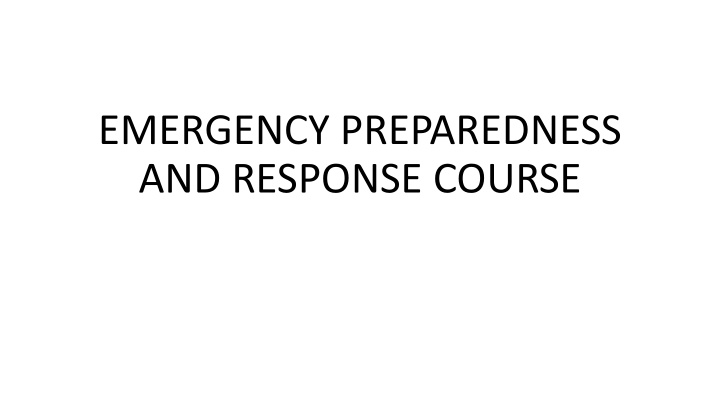



EMERGENCY PREPAREDNESS AND RESPONSE COURSE
In Introduction • Across the world, the humanitarian system has been pushed further than ever before by the need to respond to an unprecedented volume and intensity of high-level emergencies from conflicts in Syria, Iraq, South Sudan, and Central African Republic, to the destructive typhoon in the Philippines, and the devastating Ebola outbreak in West Africa. • Kenya has also witnessed a number of disasters and emergencies in the recent past.
The Humanitarian Leadership Academy (Academy) and the Kenya Institute of Management (KIM) joined forces in 2014 to offer Certification Program in Emergency Preparedness and Response.
HUMANITARIAN LEADERSHIP ACADEMY The Humanitarian Leadership Academy will work with the humanitarian sector and new partners from the technology industry, private sector and universities to help communities become more resilient in the face of disaster and give them the training and skills to respond to crises in their own countries. In kenya, the Academy will operate locally – devolving strategic and operational responsibility to centres in each location where local priorities and programmes will be developed based on the needs of those locations. HUMANITARIAN LEADERSHIP ACADEMY
The Academy in Kenya • The Kenya Academy Centre is expected to reach 4182 people directly and at least an additional 12,547 indirectly through training. A further 25,000 people will have their skills recognised, and five organisations will be supported to develop sustainable business models and will develop MOUs with 9 organisations to support the development of new products or the quality, impact, scalability, accessibility, and sustainability of existing products. HUMANITARIAN LEADERSHIP ACADEMY
The Kenya Institute of Management The Kenya Institute of Management (KIM) is a membership based non-profit making professional management organization committed to the promotion of excellence and integrity in the practice of management. The Institute was established in 1954 as a premier institute that provides management consultancy and capacity building services to corporate organizations and other institutions.
Our Core Values • Excellence: To champion, promote and advocate for individual and institutional excellence in Kenya, Africa and beyond, in everything that we think, say or do. • Integrity: To be a pillar and beacon of good governance; to maintain the highest ethical and professional standards, honesty, truthfulness and decorum in all our dealings with our staff, customers and the community. To champion a free, just and fair community. • Innovativeness: To encourage and promote an environment that nurtures individual and institutional innovativeness and creativity, freshness of thought and the spirit of exploration and discovery. • Entrepreneurship: To champion and support creation of new wealth and employment, through the spirit of entrepreneurship. • Collaboration: To seek and reach out to likeminded individuals and institutions for collaborative and synergistic initiatives for the universal good of humankind.
WHY THE COURSE? Certification in Emergency Preparedness and Response Programme is meant to: • Build nationwide capacity for faster response to address these crisis • Equipping participants with knowledge and skills for a more coordinated emergence and disaster response
Cont …. • It aims to reach new stakeholders in their locality, bridge resilience and emergency response • To benefit people who are at the frontline of disaster response and management of humanitarian crises across the country, whether they work in the public or not-for-profit sectors, or they volunteer. • Corporates will also be encouraged to build capacity in their teams to effectively take leadership within and outside their organizations should a disaster strike. As such
COURSE OBJECTIVES Following the course, participants will be able to: • explain key concepts in relation to emergency preparedness and response; • analyse emergency risk and design response plan; • demonstrate leadership in an emergency situation; and • raise awareness of emergency preparedness and response.
TARGET GROUP • Health and Safety teams • Security Managers and coordinating teams • Branch Managers • Station Managers
Target Groups. Cont … • School Heads • County Directors/Managers • Heads of Departments
COURSE CONTENT Unit 1: provides a Theoretical Background (covering a history of humanitarianism and disaster management in Kenya); Unit 2: Introduction to Preparedness (including disaster risk management, safety and security, etc.); Unit 3: Leadership in Emergency Response (covering leadership models, communication and networking, conflict resolution and decision-making); Unit 4: Emergency response (including needs assessment, logistics, resource mobilisation, funding and budgeting and evaluation).
Contents Unit 1: Theoretical Background History of Humanitarian response Humanitarian Sector Disaster management in Kenya Unit 2: Preparedness Disaster risk management Safety and security Cross-cutting issues Capacity building skills Unit 3: Leadership in emergency response Managing yourself Leadership models Communication and networking Conflict resolution Science and art of decision making Unit 4: Emergency response Needs assessment Humanitarian accountability Technical sectors in humanitarian response Logistics Human resource mobilisation Funding and budgeting Recovery and development Evaluation of response
PROGRAMME DELIVERY • By specialist trained facilitators who are either management experts or humanitarian specialists • Face-to-face class – Seminar Approach – Evaluations – Simulations
ATTENDANCE PATTERN • Option one: Weekday – 2 hours (6.00pm to 8.00pm) - four (4) times a week. • Option two: Saturday OR Sunday only – 8 Hours • Duration: 3 months (80-90 Hours) • 4 intakes per year; January, April, July and October. • Pilot Class - January 2016
If you or your organisation is interested in finding out more about this exciting new course, please contact the KIM or Academy delegates at the conference, who would be pleased to answer any queries.
Thank You!
Recommend
More recommend